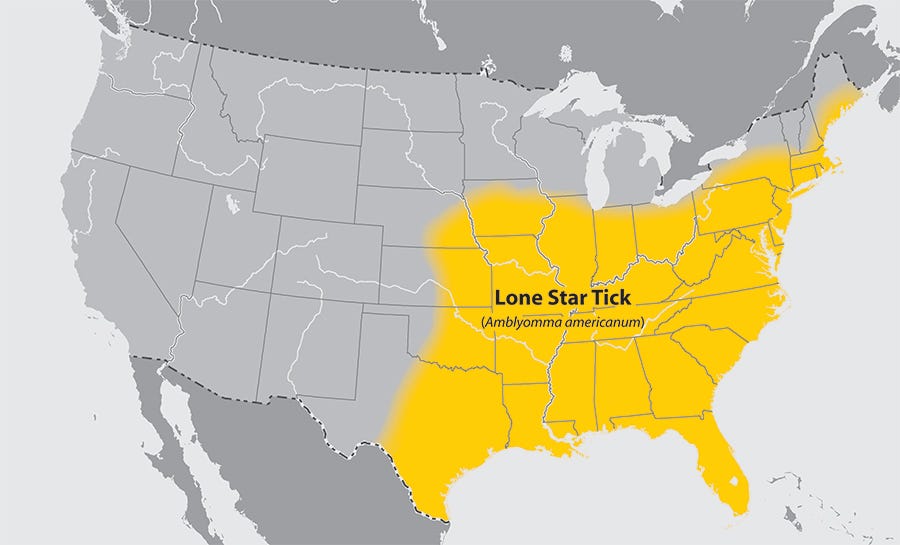After keeping a food journal for nearly a year, Coughlin realized his symptoms occurred after eating meat, primarily pork. “I essentially spent a week proving my point,” Coughlin says. “I’d eat a bunch of red meat, and go through a series of pretty severe reactions.”
When he finally went to the hospital in 2016, the doctor tested him for all the usual allergies and was flummoxed by the lack of results. She gave him a strong antihistamine and an EpiPen and sent him home.
Frustrated, Coughlin started researching. He found similarities between his symptoms and documented cases of something called alpha-gal allergy. A major study on the allergic reaction had been done right across the Blue Ridge Mountains at the University of Virginia.
Suddenly, his hiking trips in that very mountain range came into focus: “I kept pulling ticks off of me,” he says. According to the research, those little brown bugs, marked by a telltale white spot, were to blame for his meat allergy. Coughlin was bit by lone star ticks.
Alpha-gal isn’t your typical hayfever-like allergy. It’s a severe, delayed-reaction immune response, which means it hits hours after someone who suffers from the allergy eats meat. People with alpha-gal describe their episodes as terrifying experiences that can land you in the emergency room and change the way you live your life.
“I was disheartened,” Coughlin says. “I’m a big eater.”
Even a decade ago, only small populations of lone star ticks were found in the northeastern U.S. As climate change shifts temperatures and humidity levels across the country, many types of ticks, which thrive in warm, humid weather, are able to expand their ranges. The EPA even uses Lyme disease, which is transmitted by blacklegged ticks, as an indicator to track where the country is warming. The spread of lone stars has been linked to climate change, and now, the ticks have made it all the way up through Maine, imparting severe red meat allergies on unsuspecting carnivores — and offering a window into our changing world and its effect on human health.
As lone stars expand into new communities this summer, the ticks are poised to catch people off guard. And just like Coughlin, these little fellows are big eaters.
Asyou read this, millions of tiny, black-and-brown-legged creatures are beginning to reawaken after laying dormant underneath layers of last year’s leaf cover.
Ticks are only second to mosquitoes as vectors for human disease. This week, the Centers for Disease Control and Prevention published a report showing illnesses from ticks, fleas, and mosquitoes are on the rise. Disease cases in the U.S. more than tripled between 2004 and 2016, and the report found that we’re ill-equipped to tackle the growing problem.
Large swaths of the eastern U.S. are already dealing with an epidemic of Lyme disease, an illness that can rob you of your short-term memory, your motor functions, and, very rarely, even your life.
And every so often, it seems, the ticks that rouse themselves from the leaf litter are armed with unexpected and mysterious pathogens, like the resurfaced Powassan virus or Pacific Coast tick fever. The CDC report says seven new tick-borne infections have been recorded since 2004. The organization hasn’t recognized alpha-gal allergies yet.
“It’s scary,” says Graham Hickling, the director of the University of Tennessee’s Center for Wildlife Health. “Pretty much every year, we’re finding something new.”
A combination of factors has allowed lone stars to conquer territories far outside their known range.
Climate change is among them. It’s likely affecting the viability rates for the thousands of eggs that a single lone star can lay at a time. “When we start getting these warm seasons, high rainfall kind of years, that probably means that those 2,000 baby ticks do a lot better,” Hickling says.
